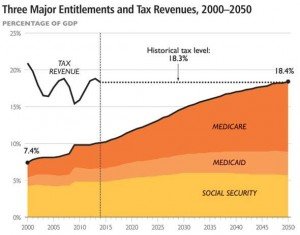Well, it looks like we may have a debt ceiling “deal.” Can we all breathe a sigh of relief? The stock market will respond well today, so on the surface people will be happier. Everybody likes compromise, and this deal makes both sides unhappy, so that’s a great compromise, right?
Well, if your idea of a compromise is getting herpes rather than AIDS, I guess that’s alright. Frankly, I’d prefer neither, and the graph at the top explains why.
Problem number one: the existing debt levels simply cannot continue. They are unprecedented (on a long-term basis) and will eventually lead to default on our debt because debt levels above 100 percent are not acceptable. In my post last week on this issue, I explained why: eventually, you can’t finance it anymore. All countries throughout history with debt levels above 100 percent eventually face an economic calamity.
This debt deal solves this, right? Aren’t we going to cut trillions?
Sorry, no.
Problem number two: all of the plans under discussion increase spending overall. So, when you hear “$2.4 trillion in cuts” or whatever the number is these days, it is based on cuts over 10 years and is based on a baseline that is already growing. The baseline calls for $6 trillion in additional deficit spending over the next 10 years. So, cutting $2.4 trillion means the deficit will grow $3.6 trillion. Nothing significant will be cut except the rate of growth. So, the budget and deficit will still grow, but they will grow slightly slower.
Problem number three: today’s Congress cannot promise what futures Congresses can do, it can only promise what the budget will be in 2012. Whatever deal is struck this week is really only good for about a year. So, any figure of cuts “over 10 years” is completely meaningless. The only figure that matters is “cuts in 2012.” And what exactly are the cuts in 2012? Well, real cuts, meaning spending cuts where we spend less rather than slow the rate of growth, are expected to be about $22 billion. Yes, you read that right. Out of a budget of $3.8 trillion we are cutting $22 billion. This is pretty much akin to having a $50,000 credit card bill and celebrating because your telephone bill is going down from $40 a month to $30 a month.
Problem number four: this deal does nothing to deal with entitlements. There are promises that a commission will look at it, but nothing firm. The entitlements are where the rubber meets the road.
As this chart shows, entitlements (Medicare, Social Security, Medicaid) are growing exponentially. The reason? The baby boom generation is about to retire. Again, this deal does nothing serious to change this long-term problem.
Problem number five: there are no serious cuts in military spending. All of the caterwauling from “conservatives” on military spending is pure bunk. Yes, by historical standards we are spending less on the military than we did in the 1960s (as a percent of GDP), but our economy has grown. The issue is: what is our long-term strategy? Why do we have hundreds of military bases around the world and why are we currently fighting in six different countries? As I said in my last post, Republicans missed an historic opportunity to “go big” by proposing big military cuts in exchange for truly cutting spending on entitlements and the massive welfare state.
Problem number six: the blame game. You will be hearing claims in the coming days about how government is too small, how the cuts will be hurting the poor (and hurting defense) and on and on. The point seems to be to score political points, and in this regard both sides are incredibly dishonest. Don’t pay any attention. This is a bipartisan problem caused by bipartisan spending on pet projects that are loved by both sides. The true long-term solution is changing our attitude toward what government should do. We need to go back to the concept of self-reliance and a small, humble government that is nearly invisible. We are a very long way from that, and the blame belongs to almost all of our politicians.


